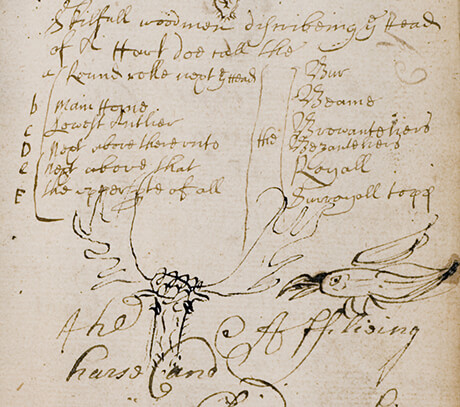Scriptorium: Medieval and Early Modern Manuscripts Online
And for the use and benefit of memory it is that both Lawyers and Divines do draw out Compendiums and abstracts of things most material and needful to be known Sir John Brownlow, first Baronet of Belton, 1594-1679
Scriptorium started life as a three-year (2006-2009) AHRC-funded Resource Enhancement Project, based in the Faculty of English at the University of Cambridge.
The project team created a digital archive of manuscript miscellanies and commonplace books from the period c. 1450-1720. These were drawn from the collections of ten partner institutions: college libraries in Cambridge (Emmanuel, King's, Queens, St John's, Trinity), the Cambridge University Library, the Brotherton Library in Leeds, and the archives of Holkham Hall, Belton House, and Lambeth Palace.
Project investigators and research associates included Richard Beadle, Colin Burrow, Andrew Zurcher, Christopher Burlinson, Sebastiaan Verweij, Angus Vine, and Raphael Lyne. The IT developer was Mariko Brittain.
The initial Scriptorium website provided unrestricted public access to the manuscript images, and included a set of online pedagogical and research resources supporting late medieval and early modern manuscript studies. By gathering examples of different kinds of miscellany and commonplace book, it enabled users to explore and compare these distinctive and intriguing products of late medieval and early modern culture.
The images, now available in higher-resolution formats owing to the continued support of the partner libraries, are now part of the Cambridge Digital Library. Also included here are the detailed descriptions of the manuscripts, and other supporting information featured in the original site.
For further materials relating to Scriptorium, including essays on the manuscripts by selected scholars, and a link to the online palaeography module English Handwriting 1500-1700: An Online Course, please visit https://www.english.cam.ac.uk/scriptorium/.
-
Elizabeth Lyttelton's commonplace book; English, French, and Latin; 1670s-1713. (MS Add. 8460)
… more -
Collection of extensive reading notes by Sir John Brownlowe; English; third quarter of the seventeenth century. (Belton MS S. 115.20)
… more -
A commonplace book under heads; Latin, Greek, English, Italian, and German; early to mid-seventeenth century. (Emmanuel MS I.3.2)
… more -
William Heveningham's book of husbandry, maxims, and current affairs; English; 1660s-1670s. (Holkham MS 685)
… more -
Edward Pordage's reading notes; English; c.1710. (King's College MS 840.5)
… more -
William Rawley's miscellany; a collection of more than 900 anecdotes, apophthegms, memoranda, proverbs, and recipes; 16... (Lambeth Palace Library MS 2086)
… more -
Alathea Bethell's book of private devotions in verse and prose; English; 1674-1708. (Lambeth Palace Library MS 2240)
… more -
Miscellany of verse, prose, drama, and other notes; English, Latin, and Greek; second half of the seventeenth century, with... (Brotherton Collection, MS Lt 91)
See this item on the Brotherton Library, Leeds University website … more -
A miscellany of household information; Latin and English; compiled in the fifteenth century. (UL MS Ll.1.18)
… more -
Merchant's notebook containing notes on the wool trade, letters and proclamations, astrological notes, travel directions,... (Cambridge, Queens' College, MS 34)
… more -
Sir Thomas Smith's 'Inventaries'; English, Latin, Law French, and Greek; 1540s-1570s. (Cambridge, Queens' College, MS 49)
… more -
Sir Thomas Smith's notebook, titled 'Recognisances & Examinacions'; English, Italian, Latin, and Greek; 1560s and 1570s. (Cambridge, Queens' College, MS 83)
… more -
Student notebook of Lawrence Breton, and a extensive collection of sermon notes; Latin, English, and Greek; first half of... (Cambridge, Queens' College, MS 90)
… more -
A miscellany of verse; English; c.1640. (St John's College MS S.23)
… more -
A collection of letters, prose passages (perhaps rhetorical exercises), and poems on university matters; Latin, English,... (St John's College MS S.31)
… more -
A miscellany of verse; English; c.1630. (St John's College MS S.32)
… more -
A mostly academic miscellany, compiled by Alexander Bolde of Pembroke College, Cambridge, and one other user; Latin, English,... (St John's College MS S.34)
… more -
A collection of carols; English and Latin; second half of fifteenth century. (St John's College MS S.54)
… more -
A miscellany of literary works in verse and prose; English and Latin; c.1450. (Trinity College MS O.9.38)
… more -
A biblical miscellany compiled by King Edward VI; French; late 1540s. (Trinity College MS R.7.31)
… more























